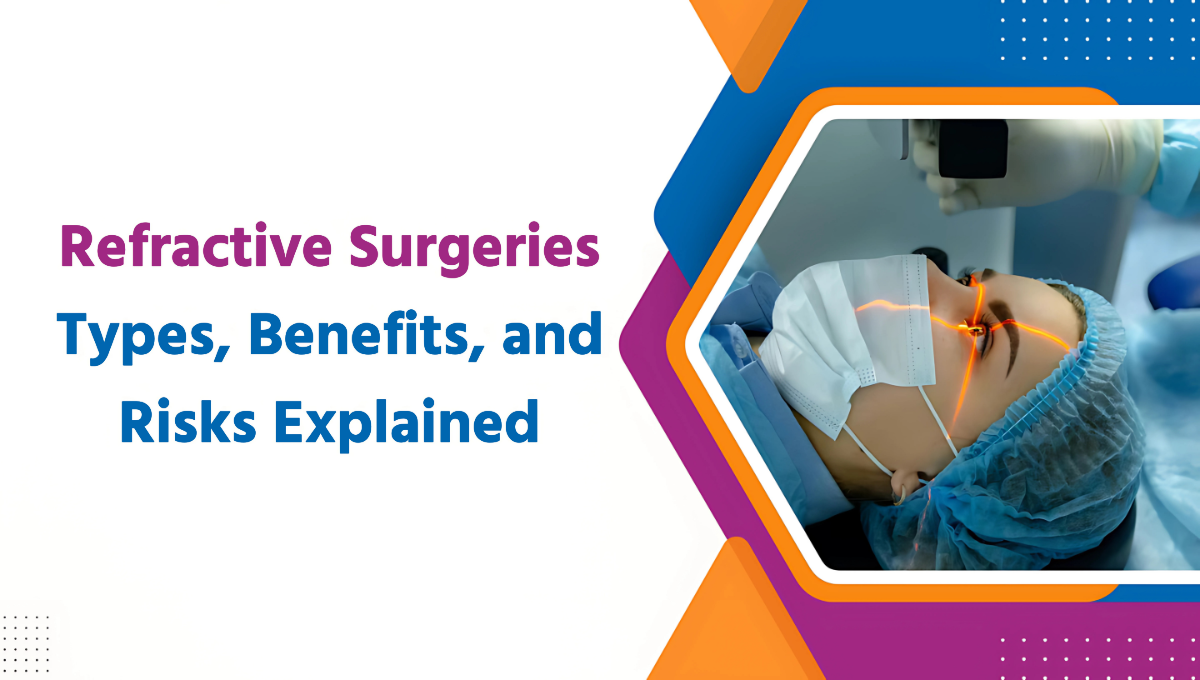Refractive surgeries are advanced eye procedures designed to correct vision problems like nearsightedness (myopia), farsightedness (hyperopia), astigmatism, and presbyopia. These surgeries reshape the cornea or replace the eye’s natural lens to improve how light focuses on the retina, reducing or eliminating the need for glasses or contact lenses.
In India, refractive surgeries have gained immense popularity due to their high success rates, quick recovery, and affordability compared to Western countries. This guide will explore the different types of refractive surgeries, their benefits, risks, and what to expect before and after the procedure.
Understanding Refractive Errors
Before diving into refractive eye surgery, it’s essential to understand refractive errors—common vision problems caused by an irregularly shaped cornea or lens.
-
Myopia (Nearsightedness): Difficulty seeing distant objects clearly.
-
Hyperopia (Farsightedness): Difficulty focusing on nearby objects.
-
Astigmatism: Blurred vision due to an irregularly curved cornea.
-
Presbyopia: Age-related difficulty in reading or seeing close objects.
Refractive surgeries aim to correct these issues by altering the cornea’s shape or replacing the eye’s natural lens with an artificial one.
Types of Refractive Surgeries
Several surgical options are available, each suited for different vision problems and patient needs.
1. LASIK (Laser-Assisted In Situ Keratomileusis)
How it works: A laser reshapes the cornea to improve light focus.
Best for: Myopia, hyperopia, and astigmatism.
Recovery: 24-48 hours.
Pros: Quick, painless, high success rate.
Cons: Not suitable for thin corneas or severe dry eyes.
2. PRK (Photorefractive Keratectomy)
How it works: The outer corneal layer is removed before laser reshaping.
Best for: Patients with thin corneas.
Recovery: 3-5 days.
Pros: Safer for certain corneal conditions.
Cons: Longer recovery than LASIK.
3. SMILE (Small Incision Lenticule Extraction)
How it works: A laser creates a small lens-shaped tissue inside the cornea, which is then removed.
Best for: Myopia and astigmatism.
Recovery: 1-2 days.
Pros: Minimally invasive, no flap complications.
Cons: Not for hyperopia or presbyopia.
4. ICL (Implantable Collamer Lens)
How it works: A biocompatible lens is implanted inside the eye without removing the natural lens.
Best for: High myopia or thin corneas.
Recovery: 1-2 days.
Pros: Reversible, no corneal alteration.
Cons: Higher cost, risk of cataracts long-term.
5. Refractive Lens Exchange (RLE)
How it works: The eye’s natural lens is replaced with an artificial intraocular lens (IOL).
Best for: Severe refractive errors or presbyopia.
Recovery: A few days.
Pros: Permanent solution, prevents cataracts.
Cons: Irreversible, risk of retinal detachment.
Refractive lens surgery is often recommended for older patients or those with extreme prescriptions who aren’t candidates for LASIK or PRK.
Who Is a Good Candidate for Refractive Surgery?
Not everyone is eligible for refractive surgery. Ideal candidates:
✔ Have stable vision for at least a year.
✔ Are over 18 (LASIK/PRK) or over 45 (RLE).
✔ Have healthy corneas and no severe dry eye.
✔ Do not have autoimmune diseases (e.g., rheumatoid arthritis).
An eye specialist will conduct tests (corneal thickness, pupil size, tear production) to determine suitability.
Benefits of Refractive Surgeries
-
Reduced Dependence on Glasses/Contacts: Most patients achieve 20/20 vision.
-
Quick Results: Improved vision within 24 hours (LASIK/SMILE).
-
Long-Term Solution: Permanent correction in most cases.
-
Enhanced Quality of Life: Better for sports, travel, and daily activities.
Risks and Complications
While refractive surgeries are generally safe, potential risks include:
-
Dry eyes (temporary or chronic).
-
Glare or halos at night.
-
Undercorrection/overcorrection (may need enhancement).
-
Rare complications like infection or corneal ectasia.
Choosing an experienced surgeon minimizes these risks.
Cost of Refractive Surgeries in India
Costs vary based on the procedure and clinic:
-
LASIK: ₹20,000 – ₹60,000 per eye.
-
PRK: ₹15,000 – ₹50,000 per eye.
-
SMILE: ₹50,000 – ₹1,00,000 per eye.
-
ICL: ₹50,000 – ₹1,20,000 per eye.
-
RLE: ₹40,000 – ₹1,50,000 per eye.
Many hospitals offer EMI options, making refractive eye surgery more accessible.
Recovery and Aftercare Tips
-
Avoid rubbing your eyes for a week.
-
Use prescribed eye drops to prevent infection.
-
Wear sunglasses to protect from UV rays.
-
Avoid swimming or heavy exercise for 2 weeks.
Most patients resume work within 2-3 days.
Conclusion
Refractive surgeries offer a life-changing solution for people tired of glasses or contacts. Whether you opt for LASIK, PRK, SMILE, ICL, or refractive lens surgery, consulting a qualified ophthalmologist is crucial. With advanced technology and skilled surgeons in India, achieving clear vision has never been easier.
If you’re considering refractive surgery, schedule a consultation to explore the best option for your eyes.
